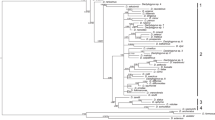Abstract
We report a new species of Allopodocotyle Pritchard, 1966 from the intestine of two species of Serranidae, Cromileptes altivelis and Epinephelus fuscoguttatus, from the southern Great Barrier Reef. Despite the examination of eight other species of Epinephelus from the same region this species appears anomalous in its distribution in one species of Epinephelus and the single species of Cromileptes. Molecular phylogenetic studies of the Epinephelinae suggest, however, that these two species are closely related so that the host specificity demonstrated by this species is actually stenoxenic (phylogenetically related hosts) rather than euryxenic.
Similar content being viewed by others
References
Barger M.A., Esch G.W. 1999. Allopodocotyle chiliticorum n. sp. (Digenea: Opecoelidae) from redlip shiners, Notropis chiliticus, in Basin Creek, North Carolina. Journal of Parasitology, 85, 891–892.
Bray R.A. 1987. Some helminth parasites of marine fishes of South Africa: family Opecoelidae (Digenea). Journal of Natural History, 21, 1049–1075.
Bray R.A., Cribb T.H. 1989. Digeneans of the family Opecoelidae Ozaki, 1925 from the Southern Great Barrier-Reef, including a new genus and three new species. Journal of Natural History, 23, 429–473.
Craig M.T., Hastings P.A. 2007. A molecular phylogeny of the groupers of the subfamily Epinephelinae (Serranidae) with a revised classification of the Epinephelini. Ichthyological Research, 54, 1–17. DOI: 10.1007/s10228-006-0367-x.
Cribb T.H. 2005. Family Opecoelidae Ozaki, 1925. In: (Eds. A. Jones, R.A. Bray and D.I. Gibson) Keys to the Trematoda. Vol. 2. CABI Publishing and The Natural History Museum, Wallingford, 443–531.
Cribb T.H., Bray R.A. 2010. Gut wash, body soak, blender and heat fixation: approaches to the effective collection, fixation and preservation of trematodes of fishes. Systematic Parasitology, 76, 1–7. DOI: 10.1007/s11230-010-9229-z.
Cribb T.H., Bray R.A., Barker S.C., Adlard R.D. 1996. Taxonomy and biology of Mitrotrema anthostomatum Manter, 1963 (Digenea: Cryptogonimidae) from fishes of the southern Great Barrier Reef, Australia. Journal of the Helminthological Society of Washington, 63, 110–115.
Cribb T.H., Bray R.A., Wright T., Pichelin S. 2002. The trematodes of groupers (Serranidae: Epinephelinae): knowledge, nature and evolution. Parasitology, 124, S23–S42. DOI: 10.1017/S0031182002001671.
Durio W.O., Manter H.W. 1968. Some digenetic trematodes of marine fishes of New Caledonia. Part II. Opecoelidae and Lepocreadiidae. Journal of Parasitology, 54, 747–756. DOI: 10.2307/3277032.
Gibson D.I. 1996. Guide to the parasites of fishes of Canada. Canadian Special Publication of Fisheries and Aquatic Sciences, NRC Research Press No. 124, Ottawa, 373 pp.
Gibson D.I., Bray R.A. 1982. A study and reorganization of Plagioporus Stafford, 1904 (Digenea: Opecoelidae) and related genera, with special reference to forms from European Atlantic waters. Journal of Natural History, 16, 529–559.
Lester R.J.G., Sewell K.B. 1989. Checklist of parasites from Heron Island, Great Barrier Reef. Australian Journal of Zoology, 37, 101–128. DOI: 10.1071/ZO9890101.
Lucas T., O’Brien E.K., Cribb T., Degnan B.M. 2005. Digenean trematodes infecting the tropical abalone Haliotis asinina have species-specific cercarial emergence patterns that follow daily or semilunar spawning cycles. Marine Biology, 148, 285–292. DOI: 10.1007/s00227-005-0077-3.
Manter H.W. 1940. Digenetic trematodes of fishes from the Galapagos Islands and the neighboring Pacific. Allan Hancock Pacific Expeditions, 2, 325–497.
Pritchard M.H. 1966. A revision of the genus Podocotyle (Trematoda: Opecoelidae). Zoologische Jahrbücher. Abteilung für Systematik, Ökologie und Geographie der Tiere, 93, 158–172.
Rice T., McGraw E., O’Brien E.K., Reverter A., Jackson D.J., Degnan B.M. 2006. Parasitic castration by the digenean trematode Allopodocotyle sp. alters gene expression in the brain of the host mollusc Haliotis asinina. FEBS Letters, 580, 3769–3774. DOI: 10.1016/j.febslet.2006.05.068.
Rigby M.C., Holmes J.C., Cribb T.H., Morand S. 1997. Patterns of species diversity in the gastrointestinal helminths of a coral reef fish, Epinephelus merra (Serranidae), from French Polynesia and the south Pacific Ocean. Canadian Journal of Zoology, 75, 1818–1827.
Rückert S., Klimpel S., Palm H.W. 2010. Parasites of cultured and wild brown-marbled grouper Epinephelus fuscoguttatus (Forsskål, 1775) in Lampung Bay, Indonesia. Aquaculture Research, 41, 1158–1169. DOI: 10.1111/j.1365-2109.2009.02403.x.
Sinitsin D. 1931. Studien über die Phylogenie der Trematoden. IV. The life histories of Plagioporus siliculus and Plagioporus virens, with special reference to the origin of Digenea. Zeitschrift für Wissenschaftliche Zoologie, 138, 409–456.
Author information
Authors and Affiliations
Corresponding author
Rights and permissions
About this article
Cite this article
Downie, A.J., Cribb, T.H. Phylogenetic studies explain the discrepant host distribution of Allopodocotyle heronensis sp. nov. (Digenea, Opecoelidae) in Great Barrier Reef serranids. Acta Parasit. 56, 296–300 (2011). https://doi.org/10.2478/s11686-011-0059-1
Received:
Published:
Issue Date:
DOI: https://doi.org/10.2478/s11686-011-0059-1




